Cantore Arithmetic is able to identify the prospect of accusation: 666. Seven is from Pleiades so now through Cantore Arithmetic a Christian is able to do their work for the claim: Satan and Jesus to follow as deviled eggs are taken at the Delicatessen.
You will have to identify the quote what came first the chicken of the egg to claim the devil comma and that would be only in general.
To identify the horoscope the identified by the local media at The Zodiac was a letter and that was a killer in the 1960s: California, U.S.A.! Scope must return to word as a horse is able to where shoes and boots, blankets, see U.S.P.C for tack and barn to the mirror.
You searched for
"SEVEN" in the KJV Bible
391 Instances - Page 1 of 14 - Sort by Book Order - Feedback
- Genesis 41:27chapter context similar meaning copy save
- And the seven thin and ill favoured kine that came up after them are seven years; and the seven empty ears blasted with the east wind shall be seven years of famine.
- 2 Chronicles 17:11chapter context similar meaning copy save
- Also some of the Philistines brought Jehoshaphat presents, and tribute silver; and the Arabians brought him flocks, seven thousand and seven hundred rams, and seven thousand and seven hundred he goats.
- Ezekiel 45:23chapter context similar meaning copy save
- And seven days of the feast he shall prepare a burnt offering to the LORD, sevenbullocks and seven rams without blemish daily the seven days; and a kid of the goats daily for a sin offering.
- Numbers 23:1chapter context similar meaning copy save
- And Balaam said unto Balak, Build me here seven altars, and prepare me here sevenoxen and seven rams.
- Numbers 23:29chapter context similar meaning copy save
- And Balaam said unto Balak, Build me here seven altars, and prepare me here sevenbullocks and seven rams.
- 2 Chronicles 29:21chapter context similar meaning copy save
- And they brought seven bullocks, and seven rams, and seven lambs, and seven he goats, for a sin offering for the kingdom, and for the sanctuary, and for Judah. And he commanded the priests the sons of Aaron to offer them on the altar of the LORD.
- Genesis 41:26chapter context similar meaning copy save
- The seven good kine are seven years; and the seven good ears are seven years: the dream is one.
- Revelation 1:20chapter context similar meaning copy save
- The mystery of the seven stars which thou sawest in my right hand, and the sevengolden candlesticks. The seven stars are the angels of the seven churches: and the seven candlesticks which thou sawest are the seven churches.
- Revelation 21:9chapter context similar meaning copy save
- And there came unto me one of the seven angels which had the seven vials full of the seven last plagues, and talked with me, saying, Come hither, I will shew thee the bride, the Lamb's wife.
- Leviticus 25:8chapter context similar meaning copy save
- And thou shalt number seven sabbaths of years unto thee, seven times seven years; and the space of the seven sabbaths of years shall be unto thee forty and nine years.
- Revelation 5:6chapter context similar meaning copy save
- And I beheld, and, lo, in the midst of the throne and of the four beasts, and in the midst of the elders, stood a Lamb as it had been slain, having seven horns and seven eyes, which are the seven Spirits of God sent forth into all the earth.
- Revelation 8:6chapter context similar meaning copy save
- And the seven angels which had the seven trumpets prepared themselves to sound.
- Revelation 8:2chapter context similar meaning copy save
- And I saw the seven angels which stood before God; and to them were given seventrumpets.
- Mark 8:20chapter context similar meaning copy save
- And when the seven among four thousand, how many baskets full of fragments took ye up? And they said, Seven.
- Genesis 5:31chapter context similar meaning copy save
- And all the days of Lamech were seven hundred seventy and seven years: and he died.
- Zechariah 4:2chapter context similar meaning copy save
- And said unto me, What seest thou? And I said, I have looked, and behold a candlestick all of gold, with a bowl upon the top of it, and his seven lamps thereon, and seven pipes to the seven lamps, which are upon the top thereof:
- Joshua 6:4chapter context similar meaning copy save
- And seven priests shall bear before the ark seven trumpets of rams' horns: and the seventh day ye shall compass the city seven times, and the priests shall blow with the trumpets.
- Revelation 15:1chapter context similar meaning copy save
- And I saw another sign in heaven, great and marvellous, seven angels having the seven last plagues; for in them is filled up the wrath of God.
- Revelation 17:9chapter context similar meaning copy save
- And here is the mind which hath wisdom. The seven heads are seven mountains, on which the woman sitteth.
- Revelation 2:1chapter context similar meaning copy save
- Unto the angel of the church of Ephesus write; These things saith he that holdeth the seven stars in his right hand, who walketh in the midst of the seven golden candlesticks;
- 2 Chronicles 30:23chapter context similar meaning copy save
- And the whole assembly took counsel to keep other seven days: and they kept other seven days with gladness.
- Revelation 12:3chapter context similar meaning copy save
- And there appeared another wonder in heaven; and behold a great red dragon, having seven heads and ten horns, and seven crowns upon his heads.
- Matthew 18:22chapter context similar meaning copy save
- Jesus saith unto him, I say not unto thee, Until seven times: but, Until seventy times seven.
- 2 Chronicles 15:11chapter context similar meaning copy save
- And they offered unto the LORD the same time, of the spoil which they had brought, seven hundred oxen and seven thousand sheep.
- Revelation 15:7chapter context similar meaning copy save
- And one of the four beasts gave unto the seven angels seven golden vials full of the wrath of God, who liveth for ever and ever.
- Job 2:13chapter context similar meaning copy save
- So they sat down with him upon the ground seven days and seven nights, and none spake a word unto him: for they saw that his grief was very great.
- 1 Chronicles 15:26chapter context similar meaning copy save
- And it came to pass, when God helped the Levites that bare the ark of the covenant of the LORD, that they offered seven bullocks and seven rams.
- Luke 17:4chapter context similar meaning copy save
- And if he trespass against thee seven times in a day, and seven times in a day turn again to thee, saying, I repent; thou shalt forgive him.
- Revelation 15:6chapter context similar meaning copy save
- And the seven angels came out of the temple, having the seven plagues, clothed in pure and white linen, and having their breasts girded with golden girdles.
- Genesis 41:7chapter context similar meaning copy save
- And the seven thin ears devoured the seven rank and full ears. And Pharaoh awoke, and, behold, it was a dream.
This is page: 1 of 14
1 2 3 4 5 6 7 8 9 10 11 12 13 14 Next >
Pleiades
| Pleiades | |
|---|---|
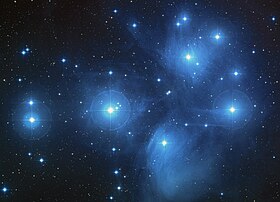 A color-composite image of the Pleiades from the Digitized Sky Survey | |
| Observation data (J2000 epoch) | |
| Right ascension | 03h 47m 24s[1] |
| Declination | +24° 07′ 00″[1] |
| Distance | 444 ly on average[2][3][4][5](136.2±1.2 pc) |
| Apparent magnitude (V) | 1.6[6] |
| Apparent dimensions (V) | 110' (arcmin)[6] |
| Physical characteristics | |
| Other designations | Seven Sisters,[1] M45,[1] Cr42,[1] Mel 22[1] |
| Associations | |
| Constellation | Taurus |
The Pleiades (/ˈpliː.ədiːz, ˈpleɪ-, ˈplaɪ-/),[7][8] also known as the Seven Sisters, Messier 45, and other names by different cultures, is an asterism and an open star cluster containing middle-aged, hot B-type stars in the north-west of the constellation Taurus. At a distance of about 444 light years, it is among the nearest star clusters to Earth. It is the nearest Messier object to Earth, and is the most obvious cluster to the naked eye in the night sky. It is also observed to house the reflection nebula NGC 1432, an HII region.[9]
The cluster is dominated by hot blue luminous stars that have formed within the last 100 million years. Reflection nebulae around the brightest stars were once thought to be left over material from their formation, but are now considered likely to be an unrelated dust cloud in the interstellar medium through which the stars are currently passing.[10] This dust cloud is estimated to be moving at a speed of approximately 18 km/s relative to the stars in the cluster.[11]
Computer simulations have shown that the Pleiades were probably formed from a compact configuration that resembled the Orion Nebula.[12] Astronomers estimate that the cluster will survive for about another 250 million years, after which it will disperse due to gravitational interactions with its galactic neighborhood.[13]
Together with the open star cluster of the Hyades, the Pleiades form the Golden Gate of the Ecliptic.
Origin of name[edit]
The name of the Pleiades comes from Ancient Greek: Πλειάδες.[14] It probably derives from plein ("to sail") because of the cluster's importance in delimiting the sailing season in the Mediterranean Sea: "the season of navigation began with their heliacal rising".[15] However, in mythology the name was used for the Pleiades, seven divine sisters, the name supposedly deriving from that of their mother Pleione and effectively meaning "daughters of Pleione".[16] In reality, the name of the star cluster almost certainly came first, and Pleione was invented to explain it.[17]
Astronomical role of M45 in antiquity[edit]
The M45 group played an important role in ancient times for the establishment of calendars thanks to the combination of two remarkable elements. The first, which is still valid, is its unique and perfectly identifiable aspect on the celestial vault near the ecliptic. The second, essential for the Ancients, is that in the middle of the third millennium BC., this asterism marked the vernal point.[18] The importance of this asterism is also evident in northern Europe, on the Nebra sky disc, dating around 1600 BC. and where it is represented beside the Sun and the Moon.

It is also this asterism that indicates the beginning of the ancient calendars. Several examples can be given:
- In ancient India, it constitutes, in the Atharvaveda, compiled around 1200-1000 BC, the first nakṣatra(Sanskrit name for lunar stations), which is called क्रृत्तिका Kṛittika, a revealing name since it literally means "the Cuttings"[19], i.e. "Those that mark the break of the year".[20] This is so before the classic list lowers this nakṣatra to third place, henceforth giving the first to the couple βγ Arietis which, notably in Hipparchus, at that time ,marks the equinox.
- In Mesopotamia, the MUL.APIN compendium, the first known Mesopotamian astronomy treatise, discovered at Nineveh in the library of Assurbanipal and dating from no later than 627 BC., presents a list of gods [holders of stars] who stand on "the path of the Moon", a list which begins with mul.MUL.[21]
- In Greece, the Πλειάδες, are a group whose name is probably functional before having a mythological meaning, as André Lebœuffle points out, who has his preference for the explanation by the Indo-European root *pe/ol-/pl- which expresses the idea of multiplicity, crowd, assembly.[22]
- We find a similar thing among the Ancient Arabs who begin their old parapegma type calendar, that of the anwā, with M45 under the name of الثريّا al-Ṯurayyā.[23] And this before their classic calendar, that of the manāzil al-qamar or "lunar stations", also begins with the couple βγ Arietis whose name, الشرطان al- Šaraṭān, is literally "the Two Marks [of entering the equinox]"[24]
So when M45 leaves the vernal point, the asterism still remains important, both functionally and symbolically. In addition to the changes we have just seen in the calendars based on the lunar stations among the Indians and the Arabs, consider the case of an ancient Yemeni calendar in which the months are designated according to an astronomical criterion which caused it to be named Calendar of the Pleiades: the month of ḫams, literally "five", is that during which the Sun and al-Ṯurayyā, ie the Pleiades, deviate away from each other by five movements of the Moon, i.e. five times the path that the "Moon" travels on average in one day and one night, to use the terminology of ᶜAbd al-Raḥmān al-Sūfī al-Ṣūfī.[25]
Nomenclature and mythology[edit]

The Pleiades are a prominent sight in winter in the Northern Hemisphere, and are easily visible from mid-Southern latitudes. They have been known since antiquity to cultures all around the world,[27] including the Celts (Welsh: Tŵr Tewdws, Irish: Streoillín); pre-colonial Filipinos (who called it Mapúlon, Mulo‑pulo, or Muró‑púro, among other names) for whom it indicated the beginning of the year,[28][29] Hawaiians (who call them Makaliʻi),[30] Māori (who call them Matariki), Indigenous Australians (from several traditions), the Achaemenid Empire, whence in Farsi(who called them پروین Parvīn or پروی Parvī),[31] the Arabs (who call them الثريا al-Thurayyā[32]), the Chinese (who called them 昴 mǎo), the Quechua (who call them Qullqa or the storehouse), the Japanese (who call them Subaru(昴, スバル)), the Maya, the Aztec, the Sioux, the Kiowa,[33][34] and the Cherokee. In Hinduism, the Pleiades are known as Kṛttikā and are scripturally associated with the war-god Kartikeya and are also identified or associated with the Saptamatrika(s) (Seven Mothers). Hindus celebrate the first day (new moon) of the month of Kartik as Diwali, a festival of abundance and lamps. The Pleiades are also mentioned three times in the Bible.[35][36]
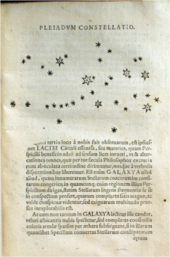
The earliest-known depiction of the Pleiades is likely a Northern German Bronze Age artifact known as the Nebra sky disk, dated to approximately 1600 BC.[37] The Babylonian star catalogues name the Pleiades MULMUL(𒀯𒀯), meaning "stars" (literally "star star"), and they head the list of stars along the ecliptic, reflecting the fact that they were close to the point of vernal equinox around the 23rd century BC. The Ancient Egyptians may have used the names "Followers" and "Ennead" in the prognosis texts of the Calendar of Lucky and Unlucky Days of papyrus Cairo 86637.[38] Some Greek astronomers considered them to be a distinct constellation, and they are mentioned by Hesiod's Works and Days,[39] Homer's Iliad and Odyssey,[40] and the Geoponica.[41] The Pleiades was the most well-known star among pre-Islamic Arabs and so often simply referred to as "the Star" (al Najm).[42] Some scholars of Islamsuggested that the Pleiades (ath-thurayya) are the "star" mentioned in Surah An-Najm ("The Star") in the Quran.[43]
On numerous cylinder seals from the beginning of the 1st millennium BC., M 45 is represented by seven points, while the Seven Gods appear, on low-reliefs of Neo-Assyrian royal palaces, wearing long open robes and large cylindrical headdresses surmounted by short feathers and adorned of three frontal rows of horns and a crown of feathers, while carrying both an ax and a knife, as well as a bow and a quiver[44]
Subaru[edit]
In Japan, the cluster is mentioned under the name Mutsuraboshi ("six stars") in the 8th-century Kojiki.[45] The cluster is now known in Japan as Subaru.[46]
It was chosen as the name of the Subaru Telescope which is the 8.2-meter (320 in) flagship telescope of the National Astronomical Observatory of Japan. It is located at the Mauna Kea Observatory on the island of Hawaii. It had the largest monolithic primary mirror in the world from its commissioning in 1998 until 2005.[47]
It was chosen as the brand name of Subaru automobiles to reflect the origins of the firm as the joining of five companies, and is depicted in the firm's six-star logo.[48]
Observational history[edit]
Galileo Galilei was the first astronomer to view the Pleiades through a telescope.[49] He thereby discovered that the cluster contains many stars too dim to be seen with the naked eye. He published his observations, including a sketch of the Pleiades showing 36 stars, in his treatise Sidereus Nuncius in March 1610.
The Pleiades have long been known to be a physically related group of stars rather than any chance alignment. John Michell calculated in 1767 that the probability of a chance alignment of so many bright stars was only 1 in 500,000, and so surmised that the Pleiades and many other clusters of stars must be physically related.[50] When studies were first made of the stars' proper motions, it was found that they are all moving in the same direction across the sky, at the same rate, further demonstrating that they were related.
Charles Messier measured the position of the cluster and included it as M45 in his catalogue of comet-like objects, published in 1771. Along with the Orion Nebula and the Praesepe cluster, Messier's inclusion of the Pleiades has been noted as curious, as most of Messier's objects were much fainter and more easily confused with comets—something that seems scarcely possible for the Pleiades. One possibility is that Messier simply wanted to have a larger catalogue than his scientific rival Lacaille, whose 1755 catalogue contained 42 objects, and so he added some bright, well-known objects to boost his list.[51]
Edme-Sébastien Jeaurat then drew in 1782 a map of 64 stars of the Pleiades from his observations in 1779, which he published in 1786.[52][53][54]
Distance[edit]
The distance to the Pleiades can be used as a key first step to calibrate the cosmic distance ladder. As the cluster is relatively close to the Earth, its distance should be relatively easy to measure and has been estimated by many methods. Accurate knowledge of the distance allows astronomers to plot a Hertzsprung–Russell diagram for the cluster, which, when compared to those plotted for clusters whose distance is not known, allows their distances to be estimated. Other methods can then extend the distance scale from open clusters to galaxies and clusters of galaxies, and a cosmic distance ladder can be constructed. Ultimately astronomers' understanding of the age and future evolution of the universe is influenced by their knowledge of the distance to the Pleiades. Yet some authors argue that the controversy over the distance to the Pleiades discussed below is a red herring, since the cosmic distance ladder can (presently) rely on a suite of other nearby clusters where consensus exists regarding the distances as established by the Hipparcossatellite and independent means (e.g., the Hyades, Coma Berenices cluster, etc.).[3]

 (click for viewing guide)
(click for viewing guide)Measurements of the distance have elicited much controversy. Results prior to the launch of the Hipparcos satellite generally found that the Pleiades were about 135 parsecs (pc) away from Earth. Data from Hipparcos yielded a surprising result, namely a distance of only 118 pc by measuring the parallax of stars in the cluster—a technique that should yield the most direct and accurate results. Later work consistently argued that the Hipparcos distance measurement for the Pleiades was erroneous.[3][4][5][55][56][57] In particular, distances derived to the cluster via the Hubble Space Telescope and infrared color-magnitude diagram fitting (so-called "spectroscopic parallax") favor a distance between 135 and 140 pc;[3][55] a dynamical distance from optical interferometric observations of the Pleiad double Atlas favors a distance of 133 to 137 pc.[57] However, the author of the 2007–2009 catalog of revised Hipparcos parallaxes reasserted that the distance to the Pleiades is ~120 pc and challenged the dissenting evidence.[2] In 2012, Francis and Anderson[58] proposed that a systematic effect on Hipparcos parallax errors for stars in clusters biases calculation using the weighted mean and gave a Hipparcos parallax distance of 126 pc and photometric distance 132 pc based on stars in the AB Doradus, Tucana-Horologium, and Beta Pictoris moving groups, which are all similar in age and composition to the Pleiades. Those authors note that the difference between these results can be attributed to random error. More recent results using very-long-baseline interferometry (VLBI) (August 2014) and preliminary solutions using Gaia Data Release 1 (September 2016) and Gaia Data Release 2 (August 2018), determine distances of 136.2 ± 1.2 pc,[59] 134 ± 6 pc[60] and 136.2 ± 5.0 pc,[61] respectively. The Gaia Data Release 1 team was cautious about their result and the VLBI authors assert "that the Hipparcos-measured distance to the Pleiades cluster is in error".
| Year | Distance (pc) | Notes |
|---|---|---|
| 1999 | 125 | Hipparcos[62] |
| 2004 | 134.6 ± 3.1 | Hubble Fine Guidance Sensor[55] |
| 2009 | 120.2 ± 1.9 | Revised Hipparcos[2] |
| 2014 | 136.2 ± 1.2 | Very-long-baseline interferometry[59] |
| 2016 | 134 ± 6 | Gaia Data Release 1[60] |
| 2018 | 136.2 ± 5.0 | Gaia Data Release 2[61] |
Composition[edit]

The cluster core radius is about 8 light-years and tidal radius is about 43 light-years. The cluster contains over 1,000 statistically confirmed members, a figure that excludes an unresolved likely further number of binary stars.[63] Its light is dominated by young, hot blue stars, up to 14 of which can be seen with the naked eye depending on local observing conditions and visual acuity of the observer. The arrangement of the brightest stars is somewhat similar to Ursa Major and Ursa Minor. The total mass contained in the cluster is estimated to be about 800 solar masses and is dominated by fainter and redder stars.[63] An estimate of the frequency of binary stars in the Pleiades is about 57%.[64]
The cluster contains many brown dwarfs, which are objects with less than about 8% of the Sun's mass, not heavy enough for nuclear fusion reactions to start in their cores and become proper stars. They may constitute up to 25% of the total population of the cluster, although they contribute less than 2% of the total mass.[65] Astronomers have made great efforts to find and analyse brown dwarfs in the Pleiades and other young clusters, because they are still relatively bright and observable, while brown dwarfs in older clusters have faded and are much more difficult to study.
Brightest stars[edit]
The nine brightest stars of the cluster are named the Seven Sisters in Greek mythology: Sterope, Merope, Electra, Maia, Taygeta, Celaeno, and Alcyone, along with their parents Atlas and Pleione.[16] As daughters of Atlas, the Hyades were sisters of the Pleiades. The following table gives details of the brightest stars in the cluster:
| Name | Pronunciation (IPA) | Designation | Apparent magnitude | Stellar classification | Distance (ly)[66] |
|---|---|---|---|---|---|
| Alcyone | /ælˈsaɪ.əniː/ | Eta (25) Tauri | 2.86 | B7IIIe | 409±50 |
| Atlas | /ˈætləs/ | 27 Tauri | 3.62 | B8III | 387±26 |
| Electra | /əˈlɛktrə/ | 17 Tauri | 3.70 | B6IIIe | 375±23 |
| Maia | /ˈmeɪ.ə/ | 20 Tauri | 3.86 | B7III | 344±25 |
| Merope | /ˈmɛrəpiː/ | 23 Tauri | 4.17 | B6IVev | 344±16 |
| Taygeta | /teɪˈɪdʒətə/ | 19 Tauri | 4.29 | B6IV | 364±16 |
| Pleione | /ˈpliːəniː, ˈplaɪ-/ | 28 (BU) Tauri | 5.09 (var.) | B8IVpe | 422±11 |
| Celaeno | /səˈliːnoʊ/ | 16 Tauri | 5.44 | B7IV | 434±10 |
| Asterope or Sterope I | /əˈstɛrəpiː/ | 21 Tauri | 5.64 | B8Ve | 431.1±7.5 |
| — | — | 18 Tauri | 5.66 | B8V | 444±7 |
| Sterope II | /ˈstɛrəpiː/ | 22 Tauri | 6.41 | B9V | 431.1±7.5 |
| — | — | HD 23753 | 5.44 | B9Vn | 420±10 |
| — | — | HD 23923 | 6.16 | B8V | 374.04 |
| — | — | HD 23853 | 6.59 | B9.5V | 398.73 |
| — | — | HD 23410 | 6.88 | A0V | 395.82 |
Age and future evolution[edit]
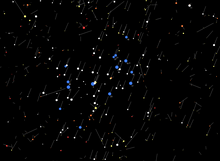
Ages for star clusters can be estimated by comparing the Hertzsprung–Russell diagram for the cluster with theoretical models of stellar evolution. Using this technique, ages for the Pleiades of between 75 and 150 million years have been estimated. The wide spread in estimated ages is a result of uncertainties in stellar evolution models, which include factors such as convective overshoot, in which a convective zone within a star penetrates an otherwise non-convective zone, resulting in higher apparent ages.[citation needed]
Another way of estimating the age of the cluster is by looking at the lowest-mass objects. In normal main-sequence stars, lithium is rapidly destroyed in nuclear fusion reactions. Brown dwarfs can retain their lithium, however. Due to lithium's very low ignition temperature of 2.5 × 106 K, the highest-mass brown dwarfs will burn it eventually, and so determining the highest mass of brown dwarfs still containing lithium in the cluster can give an idea of its age. Applying this technique to the Pleiades gives an age of about 115 million years.[67][68]
The cluster is slowly moving in the direction of the feet of what is currently the constellation of Orion. Like most open clusters, the Pleiades will not stay gravitationally bound forever. Some component stars will be ejected after close encounters with other stars; others will be stripped by tidal gravitational fields. Calculations suggest that the cluster will take about 250 million years to disperse, with gravitational interactions with giant molecular clouds and the spiral arms of our galaxy also hastening its demise.[69]
Reflection nebulosity[edit]

With larger amateur telescopes, the nebulosity around some of the stars can be easily seen; especially when long-exposure photographs are taken. Under ideal observing conditions, some hint of nebulosity around the cluster may even be seen with small telescopes or average binoculars. It is a reflection nebula, caused by dust reflecting the blue light of the hot, young stars.
It was formerly thought that the dust was left over from the formation of the cluster, but at the age of about 100 million years generally accepted for the cluster, almost all the dust originally present would have been dispersed by radiation pressure. Instead, it seems that the cluster is simply passing through a particularly dusty region of the interstellar medium.[10]
Studies show that the dust responsible for the nebulosity is not uniformly distributed, but is concentrated mainly in two layers along the line of sight to the cluster. These layers may have been formed by deceleration due to radiation pressure as the dust has moved towards the stars.[70]
Possible planets[edit]
Analyzing deep-infrared images obtained by the Spitzer Space Telescope and Gemini North telescope, astronomers discovered that one of the cluster's stars, HD 23514, which has a mass and luminosity a bit greater than that of the Sun, is surrounded by an extraordinary number of hot dust particles. This could be evidence for planet formation around HD 23514.[71]



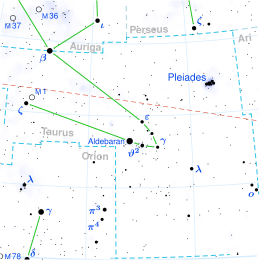
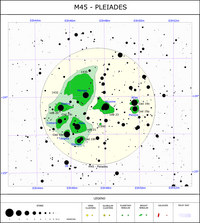
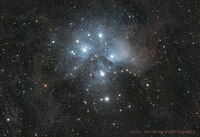









No comments:
Post a Comment